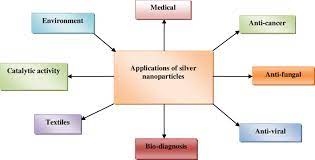
New Generation of Antimicrobial
Silver Nanoparticle Applications metal has long been used in ayuriedic therapeutics since ancient times due to
its effeciene anti microbial properties. Silver Nanoparticle of various concentrations were supplemented in liquid
systems. As results, Yeast and E. coli were inhibited at the low concentration of Ag nanoparticles, whereas the
growth-inhibitory effects on S.aureus were mild. The free-radical generation effect of Silver nanoparticle on
microbial growth inhibition was investigated by electron spin resonance spectroscopy
Silver Nanoparticle have emerged as an arch product in this field due to its anti microbial properties. The use of
silver based antimicrobial agents has emerged due to the fact that an increase of bacterial resistance to
antibiotics. An improved bactericidal activity is attributed to AgNPs because of their electronic effects that
results a change in the local electronic structure of the surfaces of the nanosized particles, i.e., enhancement of
the reactivity of Silver nanoparticle surfaces. The Silver Nanoparticle Applications are capable of inactivating the
vital enzymes and also help in prevention of the replication of DNA. silver nanopartilcle applications were used
to target the bacterial membrane to destabilize the plasma membrane potential that leads to the depletion of
the levels of intracellular adenosine triphosphate, resulting in the death of bacterial cells.
Antimicrobials
Silver Nanoparticle Applications Some of the earliest medical uses of nanotechnology have involved
antimicrobial coating often made of Silver Nanoparticle Applications, on wound dressing to prevent infection
and on things like catheters to prevent the formation of bio films. There has even been work on application of
silver nanoparticle solution directly to wounds.
Nanoparticles are used in Dental biomaterial:
Bio-films through the use of nanoparticles with biocide, anti-adhesive, and drug delivery. Silver nanoparticles
materials, include spherical, cubic, and needle-like nanoscaled particles and near-nanoscaled device. Silver
Nanoparticle coated on surfaces which have potential antimicrobial applications with in oral cavity. It is generally
recognized that silver nanoparticles may attach to the cell wall, thus disturbing cell-wall permeability and cellular
respiration. The nanoparticles may also penetrate inside the cell causing damage by interacting with phosphorus and sulphur containing compounds such as DNA and protein. Generally, silver does not adversely affect viable cells and does not easily provoke microbial resistance. Hence silver containing materials were also employed in
textile fabrics, as food additives, and in package and plastics to eliminate microorganisms. Because of such a
wide range of applications, numerous methods concerning the fabrication of silver nanoparticles, as well as
various silver-based compounds containing metallic silver (Silver Nanoparticle Applications) have been
developed.
